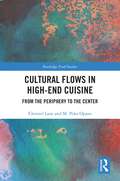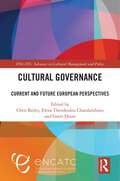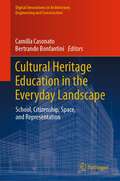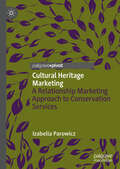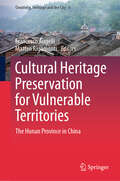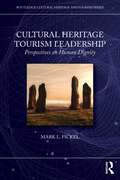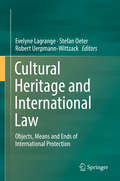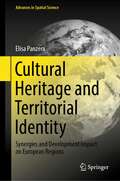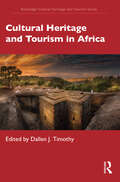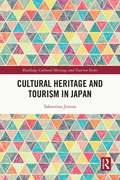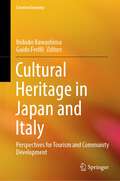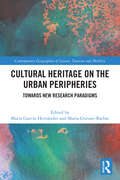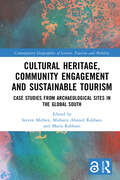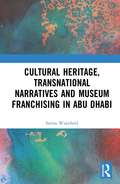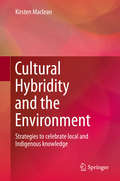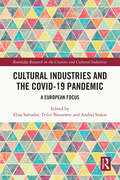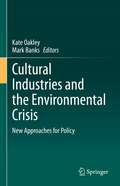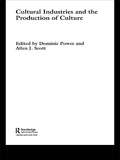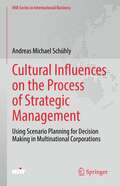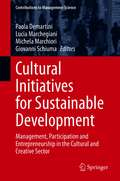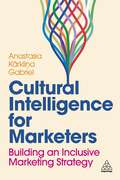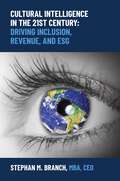- Table View
- List View
Cultural Flows in High-End Cuisine: From the Periphery to the Center (Routledge Food Studies)
by Christel Lane M. Pilar OpazoFocusing on high-end cuisine, this book examines the flows of culinary knowledge from culturally peripheral locations to two cities at the global center, London and New York.Through the voices of chefs and other professionals in the industry, this book invites readers to rethink our understandings of high-end and ethnic cuisines, as well as the conventions and principles that shape the contemporary field of gastronomy and fine-dining. It examines a broad range of cuisines, including Peruvian, Korean, Mexican, Malaysian, Senegalese, West African, Thai, Chinese, and Indian, and conveys the chefs’ voices as they strive to elevate their cuisines through discursive and material means, including the shaping of menus, and restaurant decor. While the main focus falls on chefs as the producers of high-end cuisines, this book also gives consideration to their consumers, that is cosmopolitan diners in the two global cities, and to the influence of culinary intermediaries judging and legitimizing their high-end status. Theoretically, this book contributes to the debate on cultural globalization. It undertakes a study of hitherto rarely examined cultural counterflows or reverse cultural globalization and analyzes both the precipitants of this occurrence and the effects of cultural counterflows on both Western global cities and the home countries of chefs.This book will be of great interest to students and scholars of food studies, food cultures, cultural globalization, and culinary studies.
Cultural Governance: Current and Future European Perspectives (ENCATC Advances in Cultural Management and Policy)
by Geert Drion Elena Theodoulou CharalambousCultural governance is currently regarded as a transversal element of public policy in Europe. This book brings together academics and policy practitioners to provide new insights into the field, exploring its contemporary dynamics, dilemmas and challenges. In light of the Cyprus Presidency in 2026, the authors reflect on the breadth and boundaries of cultural governance in a European perspective, the role of international institutions, such as UNESCO and the EU, and the frameworks and dilemmas of cultural governance as a dedicated practice. Particular attention is given to the relationship between culture and human creativity, to cultural rights and to climate breakdown, placing cultural governance at the heart of integrated public policy. As a key contribution that enriches the field of cultural policy, this book is essential reading for academics and offers guidance for concerted action for policymakers and legislators.
Cultural Heritage
by Michael Beverland Adam Lindgreen Adriana Campelo Laura ReynoldsCultural Heritage is a systematic, interdisciplinary examination of cultural heritage, which provides an up-to-date view of the field by drawing on various disciplines. The book offers a thorough, structured review of extant literature on heritage in tourism and pertinent challenges for cultural heritage. This book offers new ways of looking at cultural heritage assets against a backdrop of increasing economic and environmental pressures. It comprises a number of sections that each examine cultural heritage from the perspective of ethics and values, community relations and development, cultural entrepreneurship, economic viability and conservation, methodologies, impacts of tourism research, consumption, and urban and immaterial heritage. Encompassing global research perspectives from public management, visual culture, environmental management, and cultural entrepreneurship, Cultural Heritage is a crucial text for those working or interested in the heritage field.
Cultural Heritage Education in the Everyday Landscape: School, Citizenship, Space, and Representation (Digital Innovations in Architecture, Engineering and Construction)
by Camilla Casonato Bertrando BonfantiniThis book summarizes work being undertaken within the School Activates Resources—stitching the lost heritage of the suburbs (ScAR) project, which addressed cultural heritage in a broad sense, as a system of values identified by the populations and in constant evolution. This tangible and intangible heritage fuels the promotion of intergenerational and intercultural dialogue and represents an opportunity for resilient social and territorial development. The book ponders the experience gained and the points of view of the different disciplines involved, examines issues such as children and youth participation in civil life or education in cultural heritage and landscape, and presents real-world experiences of heritage education in everyday landscape in difficult contexts and/or concerning poorly recognized and valued cultural heritage.
Cultural Heritage Marketing: A Relationship Marketing Approach to Conservation Services
by Izabella ParowiczProviding an overview of the marketing principles and tools that pertain to the area of heritage conservation services, this book combines research and practice to offer an alternative to the classical transactional marketing approach. Instead, the author argues for the relationship marketing approach, promoted and adopted by the Nordic School of Service Marketing. Offering a startlingly rare, but logical and practical marketing approach, this book also provides food for thought for academics dealing with managerial and marketing aspects in the field of cultural heritage and cultural heritage services.
Cultural Heritage Preservation for Vulnerable Territories: The Hunan Province in China (Creativity, Heritage and the City #6)
by Francesco Augelli Matteo RigamontiThis book frames the many-sided fragilities of Hunan Province’s Heritage. It originates from a ten-year-long international cooperation between Politecnico di Milano (Italy), dealing from the Seventies with architectural preservation and adaptive reuse’s teaching and research activities, and the School of Architecture of the Hunan University of Changsha (China). From the Preservation of Landscape Heritage to Historical cities and settlements preservation and ancient and modern architecture preservation, the tangible and intangible cultural heritage protection and valorization, from the social repercussions to the environmental issues, the contributions introduce different aspects of Hunan territory’s cultural richness and fragility. The common aim of the rich mosaic of case studies presented at different scales is mapping, understanding, and considering the weaknesses of sites to be addressed sustainably. This is done while seeking cultural resilience-driven preservation solutions regarding operational guidelines and policies, risk assessment, social awareness, and teaching innovation. There is also a focus on virtuous multi-scale management of advanced digital technologies used to describe the current conditions and to drive the compatible design methodology on cultural heritage.
Cultural Heritage Tourism Leadership: Perspectives on Human Dignity (Routledge Cultural Heritage and Tourism Series)
by Mark L. PickelThis book proposes a novel transformational humanistic leadership approach applied to cultural heritage tourism, based on humanistic values of human dignity, creativity, and autonomy and supported by a distinctive leadership ethos, purpose, and guiding principles that promote the betterment of society.By reimagining how cultural heritage tourism leadership upholds human dignity through tour experiences that generate moments of grounding, reflection, understanding, and healing, humanistic leadership provides an ethical framework and strategic alignment to encourage human flourishing. In proposing a pluralistic leadership ethic that unites social, ecological, and technological influences, the impact of cultural heritage tourism on visitors’ human dignity is considered, culminating in transformational humanistic leadership that promotes tourism sustainability, authenticity, and adaptability. Practical leadership challenges are explored through case studies and leadership inquiries that reflect the cultural complexity of international heritage tourism, including Avebury Neolithic stone henge in the United Kingdom, Caerleon Roman Fortress and Baths in Wales, the Museum of the Cherokee People in the United States, and the Meissen Porcelain Manufactory in Germany.Cultural heritage tourism leaders, public history and anthropology scholars, those interested in applied humanism in heritage contexts, and leadership ethicists will benefit from reflecting on human dignity as a central tenant of transformational humanistic leadership.
Cultural Heritage and International Law: Objects, Means and Ends of International Protection
by Stefan Oeter Evelyne Lagrange Robert Uerpmann-WittzackThis book explores the objects, means and ends of international cultural heritage protection. It starts from a broad conception of cultural heritage that encompasses both tangible property, such as museum objects or buildings, and intangible heritage, such as languages and traditions. Cultural heritage thus defined is protected by various legal regimes, including the law of armed conflicts, UNESCO Conventions and international criminal law. With a view to strengthening international protection, the authors analyze existing regimes and elaborate innovative concepts, such as blue helmets of culture and safe havens for endangered cultural heritage. Finally, the ends of international protection come to the fore, and the authors address possible conflicts between protecting cultural diversity and wishes to strengthen cultural identity.
Cultural Heritage and Territorial Identity: Synergies and Development Impact on European Regions (Advances in Spatial Science)
by Elisa PanzeraThis book explores and substantiates the role of cultural heritage as an engine for local socio-economic development. Starting from the assumption that cultural heritage represents a valuable, unique and irreplaceable resource for European regions, it identifies and quantitatively analyzes tourism and territorial identity as two different channels through which cultural heritage can influence local socio-economic development. The book highlights the fact that cultural heritage not only has a positive influence on local cultures, societies and environments, but also plays a role in the process of local economic growth. Providing comprehensive empirical evidence that explains and discusses whether and how the endowment of cultural heritage benefits local socio-economic growth, it will appeal to scholars and students of cultural economics and regional science, and anyone interested in sustainable socio-economic development.
Cultural Heritage and Tourism
by Dallen J. TimothyOne of the most salient forms of modern-day tourism is based on the heritage of humankind. The majority of all global travel entails some element of the cultural past, as hundreds of millions of people visit cultural attractions, heritage festivals, and historic places each year. The book delves into this vast form of tourism by providing a comprehensive examination of its issues, current debates, concepts and practices. It looks at the social, physical and economic impacts, which cause destinations, site managers and interpreters to consider not only how to plan and manage resources but also how to portray the past in ways that are acceptable, accurate, accessible and politically relevant. In the process, however, the depth of heritage politics, the authenticity and inauthenticity of place and experience, and the urgent need to protect living and built cultures are exposed. The book explores these and many other current issues surrounding the management of cultural resources for tourism. In order to help students relate concepts to real-world situations it combines theory and practice, is student learning oriented, is written accessibly for all readers and is empirically rich.
Cultural Heritage and Tourism in Africa (Routledge Cultural Heritage and Tourism Series)
by Dallen J. TimothyCultural Heritage and Tourism in Africa examines the multiple and diverse manifestations of cultural heritage-based tourism in Africa from a regional, social science, and sustainability perspective. This book delivers a comprehensive treatise on the interdependent concepts of cultural heritage and tourism. Heritage is one of the most pervasive tourism assets worldwide and lies at the foundations of tourism in many localities, including Africa. However, despite its salience, there has not been a systematic examination of Africa’s heritage resources, markets, policies, practices, successes, and challenges in a tourism framework, despite the continent’s immense heritage value. This book reviews the different types of heritages that pervade the cultural environment of Africa and comprises its vast heritagescapes. It also examines the increasing potential for the growth of heritage tourism throughout the entire continent. The contributions in this volume delve into current thinking about space and place and their effects on heritage, mobilities, globalization, colonialism and indigeneity, conflict, identity and nation-building, connections with other regions through migration and the slave trade, and a greater emphasis on the ordinary heritage of Africa, which has long been ignored by tourism scholars and industry representatives. The chapters herein are authored by Africa specialists, most being from Africa, offering a truly African perspective. The chapters are conceptually rigorous and empirically rich with examples from all regions of the African continent. This unparalleled interdisciplinary glimpse at cultural heritage and tourism in Africa delivers strong value and is a vital resource for all students and researchers of tourism, cultural studies, heritage studies, geography, anthropology, sociology, history, and global studies.
Cultural Heritage and Tourism in Japan (Routledge Cultural Heritage and Tourism Series)
by Takamitsu JimuraThis book offers a comprehensive understanding of cultural heritage in Japan and its relationship with both domestic and international tourism. Japan has witnessed an increase in tourism, with rising visitor numbers to both established destinations and lesser known sites. This has generated greater attention towards various aspects of Japanese culture, heritage and society. This book explores these diverse aspects of everyday life in Japan and their interconnections with tourism. It begins with a conceptual framework of key theories related to heritage and tourism, serving as a useful apparatus for further discussions in the following chapters. Each chapter studies a specific aspect of Japan’s cultural heritage, from the history of Japan, the development of war sites, such as Hiroshima and Nagasaki, to tourist destinations, indigenous communities and their places of residence, festivals such as matsuri, to popular culture and media. Each chapter discusses a certain type of cultural heritage first in a global context and then examines it in a Japanese context, aiming to demonstrate the relation between these two different contexts. In each chapter, furthermore, how a particular kind of Japan’s cultural heritage is utilised as tourism resources and how it is perceived and consumed by international and domestic tourists are discussed. Finally, the book revisits the conceptual framework to suggest future directions for cultural heritage and tourism in Japan. Written in an informative and accessible style, this book will be of interest to scholars, students and practitioners in the fields of tourism, cultural studies and heritage studies.
Cultural Heritage in Japan and Italy: Perspectives for Tourism and Community Development (Creative Economy)
by Nobuko Kawashima Guido FerilliThis edited book represents one of the first scholarly research through an international collaboration project between Japan and Italy to address economic and social values of cultural heritage beyond its inherent—historic, archaeological, or aesthetic—values. Cultural policies in the world have over the decades expanded to include non-cultural purposes such as economic development and social inclusion. Japanese cultural policy for heritage is catching up on this trend: we have seen major shifts of emphasis from preservation for its sake to the utilisation of cultural heritage for the purposes of tourism, place branding, local vitalization and community-building, whilst Italy has long thrived on the economy of heritage tourism and more cases are being seen for urban and regional development with the use of cultural assets. The recent outbreak of Covid-19 and the problem of over-tourism that preceded it have challenged tourism policy and practice in the two countries.This book identifies emerging trends, issues, and problems in such policy shifts. The book breaks a new ground in the bourgeoning studies of tourism, heritage, and cultural policy by adopting an international, inter-disciplinary approach. The chapters on Japan in particular make an original contribution to these fields in the English literature in which discussion of Japan despite its economic and cultural presence on the globe has hitherto been less available.
Cultural Heritage on the Urban Peripheries: Towards New Research Paradigms (Contemporary Geographies of Leisure, Tourism and Mobility)
by Maria Gravari-Barbas María García-HernándezThis innovative and insightful book critically explores how to recognize and generate the social, cultural, political and economic values of the heritage of urban peripheries and encourage new metropolitan development scenarios that protect and build upon that cultural heritage.Expert-led and richly illustrated throughout, the text addresses issues such as the management and development of the cultural heritage of urban peripheries, community involvement, the relationship of youth with cultural heritage, the heritage of ethnic communities and their cultural identity, tourism development supported by heritage resources and the art-heritage relationship at urban peripheries. It looks at the whole spectrum of heritage of the metropolitan peripheries including architectural heritage (industrial areas, factories and warehouses); transport infrastructure (canals and railways); social housing, and contemporary residential architecture. It also comprises the rich intangible heritages of working-class and/or migrant communities, in process of constant change and reconfiguration through protest, negotiation and cultural expression. This significant volume reveals the heterogeneity of the existing cultural heritage in the urban peripheries, the complexity of the processes of recognition and social appropriation of these assets as well as their need for protection.This is a pivotal resource for students, scholars and academics of urban studies, tourism studies and cultural studies, as well as those with an interest in these topics more generally.
Cultural Heritage, Community Engagement and Sustainable Tourism: Case Studies from Archaeological Sites in the Global South (Contemporary Geographies of Leisure, Tourism and Mobility)
by Steven Mithen Mubariz Ahmed Rabbani Maria RabbaniThis timely and innovative book critically explores how cultural heritage in the Global South can be used to mobilise community engagement and promote sustainable tourism at archaeological sites.Whilst the volume covers theoretical issues, it primarily offers insight into how both small and large projects within low- and middle-income countries start, plan and develop. It describes what factors lead some projects to succeed, some to fail and most to have elements of both. Core to this investigation, each specifically commissioned chapter considers the challenges of developing collaboration and joint ownership between multiple stakeholders, ranging from local communities to national governments. In addition, the book considers how the challenges of the COVID-19 pandemic were managed, with lessons for future events of such magnitude. In summary, this significant volume recognises the value of developing collaborative partnerships between academics, NGOs and local communities, to achieve community engagement within archaeological research and support sustainable development by developing appropriate forms of tourism at archaeological sites. It provides essential reading for those interested in tourism, heritage studies, archaeology, geography, tourism studies and cultural studies.The Open Access version of this book, available at http://www.taylorfrancis.com, has been made available under a Creative Commons [Attribution-Non Commercial-No Derivatives (CC BY-NC-ND)] 4.0 license.
Cultural Heritage, Transnational Narratives and Museum Franchising in Abu Dhabi
by Sarina WakefieldThis publication contributes to new understandings of how heritage operates as a global phenomenon and the transnational heritage discourses that emerge from this process. Taking such a view sees autochthonous and franchised heritage not as separate or opposing elements but as part of the same process of contemporary globalised identity-making, which contributes to the development of newly emergent cosmopolitan identities. The book critically examines the processes that are involved in the franchising of heritage and its cultural effects. It does so by examining the connections and tensions that emerge from combining autochthonous and franchised heritage in the United Arab Emirates, providing a unique window in to the process of creating hybrid heritage in non-Western contexts. It develops new ideas about how this global phenomenon works, how it might be characterised and how it influences and is itself affected by local forms of heritage. By exploring how autochthonous and franchised heritage is produced in Abu Dhabi in the United Arab Emirates it becomes clear that Western-dominated practices are often challenged and, perhaps more importantly, that new ways of understanding, producing and living with heritage are being articulated in these previously marginal locations. The book offers innovative insights into heritage as a transnational process, exploring how it operates within local, national and international identity concerns and debates. It will appeal to scholars and students interested in critical heritage studies, museums, tourism, cultural studies and Middle Eastern studies.
Cultural Hybridity and the Environment: Strategies to celebrate local and Indigenous knowledge
by Kirsten MacleanThis book highlights the importance of diversity in overcoming issues of social and environmental degradation. It presents conceptual and practical strategies to celebrate local and Indigenous knowledge for improved community development and environmental management. David Harvey has proclaimed, "The geography we make must be a peoples' geography. " This clarion call challenges geographers around the world to consider the power and potential of geographic knowledge as the basis for social action - a call this book answers, providing readers the theoretical and conceptual tools needed to understand the social world and empowering them to mobilize social change. The author uses empirical case studies of two environmental management and community development projects to document how knowledge generation is "essentially locally situated and socially derived. " In doing so she charts a path for moving beyond what Vandana Shiva so aptly describes as "monocultures of the mind. " The book argues that local and Indigenous knowledge must not be seen in opposition to scientific knowledge, as none of these knowledge traditions hold all the answers to localized socio-environmental problems. Rather, as the author explores through a set of processes and strategies to enable, support and celebrate 'cultural hybridity' at the local environmental governance scale, these respective knowledge systems can learn to speak to each other. Such dialogue has the potential to support more sustainable outcomes at multiple environmental governance locales. This book will be of interest to everyone involved in environmental policy, planning or politics, and for those who want to make this planet a more sustainable and just place.
Cultural Industries and the Covid-19 Pandemic: A European Focus (Routledge Research in the Creative and Cultural Industries)
by Elisa Salvador Trilce Navarrete Andrej SrakarAlready dealing with disruptive market forces, the creative and cultural industries (CCIs) faced fundamental challenges resulting from global health crisis, wrought by the COVID-19 pandemic. With catastrophic changes to cultural consumption, cultural organisations are dealing with short, medium and long-term threats to livelihoods under lockdown. This book aims at filling the literature gap about the consequences of one of the hardest crises - COVID-19 - severely impacting all the fields of the CCIs. With a focus on European countries and taking into account the evolving and unstable context caused by the pandemic still in progress, this book investigates first reactions and actual strategies of CCIs’ actors, government bodies and cultural institutions facing the COVID-19 crisis and the potential consequences of these emergency strategies for the future of the CCIs. Creative solutions adopted facing the repeated lockdowns could reveal beneficial also after the crisis and could originate new forms of cultural consumption or innovative market strategies. This book brings together a constellation of contributors to analyse the cultural sector as it seeks to emerge from this existential challenge. The global perspectives presented in this book provide research-based evidence to understand and reflect on an unprecedented period, allowing reflective practitioners to learn and develop from a range of real-world cases. The book will also be of interest to researchers, academics and students with a particular interest in the management of cultural and creative organizations and crisis management.
Cultural Industries and the Environmental Crisis: New Approaches for Policy
by Kate Oakley Mark BanksThis volume critiques the current model of the creative economy, and considers alternative models that may point to greener, cleaner, more sustainable and socially just cultural and creative industries. Aimed at the nexus of cultural and environmental concerns, the book assesses the ways in which arts and cultural activities can help develop ideas of the ‘good life’ beyond excessive and unsustainable material consumption, and explores the complex interactions between cultural prosperity, place and the quality (and availability) of employment, leisure and the rights to self-expression. Adopting a deliberately wide and inclusive interdisciplinary and international perspective, contributors to this volume showcase current and future ways of ‘doing’ creative economy, ecologically, otherwise and differently. In 11 chapters, the book outlines some of the most relevant arguments from among the growing literature that critically analyzes the current creative economy, with a focus on issues of gentrification, inequality and environment. This volume is timely, as it emerges into a political and economic context that is seeking desperately to ‘reboot’ the economy, re-establish ‘business as usual’ and to do so partly through significant investment and expansion in the creative economy. The book will be suitable for upper level undergraduates and postgraduates studying a wide range of topics, including: cultural and creative industries, media and communications, cultural studies, cultural policy, human geography, environmental humanities and environmental policy, and will be of further interest to arts professionals, creative economy researchers and policymakers. The chapter “Towards a New Paradigm of the Creative City or the Same Devil in Disguise? Culture-led Urban (Re)development and Sustainability” is available open access under a Creative Commons Attribution 4.0 International License via link.springer.com.
Cultural Industries and the Production of Culture (Routledge Studies in International Business and the World Economy #Vol. 33)
by Dominic Power Allen J. ScottSince the Second World War there has been considerable growth in the importance of non-manufacturing based forms of production to the performance of many Western economies. Many countries have seen increased contributions being made by industries such as the media, entertainment and artistic sectors. Gathering together a leading international, multi disciplinary team of researchers, this informative book presents cutting-edge perspectives on how these industries function, their place in the new economy and how they can be harnessed for urban and regional economic and social development.
Cultural Influences on the Process of Strategic Management: Using Scenario Planning for Decision Making in Multinational Corporations (MIR Series in International Business)
by Andreas Michael SchühlyThis unique book is positioned at the crossroads of strategic management and international business. Based on an in-depth literature review, the author empirically assesses the widely shared, implicit assumption that strategic management processes can be globally applied in a standardized, i.e., culture-free, manner. So far, a variety of tools have also been recommended but without incorporating cultural differences. As many organizations observe that this ethnocentric view is more an illusion than reality, strategic management research has started to focus on the cultural sensitivity of its theories, tools, and processes to provide practitioners in a multicultural setting with adequate know-how and tools. To foster long-term decision-making despite uncertainty, scenario planning is frequently applied by practitioners. Up until today, scenario planning has however gained little attention from the academic community. Through this book, the author presents a newly developed framework for strategic management that combines the cultural value scale to test the cultural sensitivity of the long-term planning tool called “scenario planning.” The different process steps of scenario planning have been individually examined for their sensitivity toward the cultural dimensions of uncertainty avoidance and long-term orientation. The investigation is based on a unique, global set of management consultants working for a leading professional service firm. The results of this research show the cultural sensitivity of scenario planning, with different degrees of the process steps and the tested cultural dimensions.
Cultural Initiatives for Sustainable Development: Management, Participation and Entrepreneurship in the Cultural and Creative Sector (Contributions to Management Science)
by Giovanni Schiuma Lucia Marchegiani Paola Demartini Michela MarchioriThis book explores the relevance of new sources, dimensions, and characteristics of knowledge for supporting creative and cultural organizations and initiatives.Special emphasis is placed on cultural heritage, participatory approaches, and entrepreneurship in the cultural and creative sector. The role of cultural heritage and contemporary culture as a source of economically effective, socially sustainable development is also discussed. The authors examine new ways of developing and testing new and innovative models of management for cultural heritage assets. In line with the participatory approaches in culture heritage governance promoted by the EU, the authors analyze participatory approaches to cultural and creative initiatives. The role of public and private actors, as well as the way they interact with each other in order to achieve collective outcomes, is of particular interest in this section of the book. With regard to cultural and creative entrepreneurship, the book adds an innovative view of cultural ventures, offering some clues from an entrepreneurial ecosystem perspective.
Cultural Intelligence for Marketers: Building an Inclusive Marketing Strategy
by Anastasia Karklina GabrielBrands not only reflect culture but actively shape societal norms and values. Move beyond performative inclusive marketing and drive the cultural conversation.A brand today can build a marketing strategy that not only effectively resonates with audiences but also meaningfully impacts society at large. Learn how to produce inclusive marketing using an approach grounded in critical perspectives on society and the impact brands wield in shaping it. In this book, cultural theorist and strategist Anastasia Karklina Gabriel draws on social analysis, media theory, and semiotics to help marketers improve cultural fluency and future-proof brand strategy by embedding equity and inclusion into every aspect of marketing. Cultural Intelligence for Marketers explains how to create an inclusive marketing strategy using an actionable approach that draws on advanced insights into culture, identity, representation, and the power of media in driving social change.The book offers an in-depth dive into the urgent need for cultural competence in marketing using a framework rooted in 4Cs: Culture, communication, critical consciousness, and community. It delves into practical aspects of conscious marketing, inclusive innovation, cultural insights, brand activism, social impact, and responsibility in business. It features insights from current and former marketing leaders at Wieden+Kennedy, Mindshare, Dentsu, and Saatchi & Saatchi, among others. Drawing on case studies from brands that are actively pursuing inclusive marketing strategies, including Microsoft, Pinterest, Billie, and REI, Gabriel outlines the process of deploying cultural intelligence to attain commercial advantage while transforming society for the better.
Cultural Intelligence in the 21st Century: Driving Inclusion, Revenue, and ESG
by Stephan M. BranchDiscover how leadership, cultural intelligence, and inclusion coalesce to create preeminent global leaders and organizations while driving revenue, inclusion, and ESG.If you are a CEO, global leader, or part of a global organization, you can revolutionize every part of your business by raising your cultural intelligence. Cultural Intelligence in the 21st Century explores nine crucial cultural competencies that will transform every part of your business, including: how you drive inclusion, revenue, and ESG how you lead global teams for better results how you increase sales and operational performance how you communicate across cultures how you build relationships and trust in other countries In recent years, organizations have become fixated on raising Environmental, Social, and Governance (ESG) because they recognize that the Millennial and Z generations are largely focused on investing in companies that better align with their personal philosophies. Global 2000 companies know this and are redirecting much of their focus to ESG in order to make their organizations more attractive to employees and investors. The &“S&” in ESG isn&’t only about social equity; it&’s about understanding the importance of how other countries conduct business. Did you know you can solve both at the same time while having a transformative financial impact on your organization? How can you build a globally inclusive culture in an organization where everyone feels seen, heard, and respected if you don&’t understand how cultures communicate, build relationships and trust, and show respect differently? You can learn the cultural competencies to do business in other countries in order to create a more inclusive environment within a global organization, which qualifies as a metric within the ESG rating. Cultural Intelligence in the 21st Century gives you the competencies you need to do this.
Cultural Intelligence in the World of Work: Past, Present, Future (Springer Series in Emerging Cultural Perspectives in Work, Organizational, and Personnel Studies)
by David C. Thomas Yuan LiaoThis book provides a comprehensive review of both the theoretical development and empirical study of the concept of cultural intelligence. A review of previous work on cross-cultural competence provides an historical backdrop against which the two main theories of cultural intelligence are presented. These two approaches, as well as the assessments derived from them, are compared and evaluated. Issues associated with the measurement of cultural intelligence are examined in detail. An important feature of the review of the empirical work on cultural intelligence is that results are discussed in terms of the relationship of the four sub dimensions of the Cultural Intelligence Scale (CQS) and also that results using the Short Form Cultural Intelligence Scale (SFCQ) and other measures of the concept are included. The review of empirical work includes studies that cast cultural intelligence as an antecedent, as a dependent variable, and as a moderator and a mediator. Cultural intelligence at the group and organizational levels are also discussed. Finally, this review sets the stage for a discussion of appropriate future directions in the study of cultural intelligence. Scholars in organizational psychology interested in the concept of cultural intelligence will find this an essential guide.
